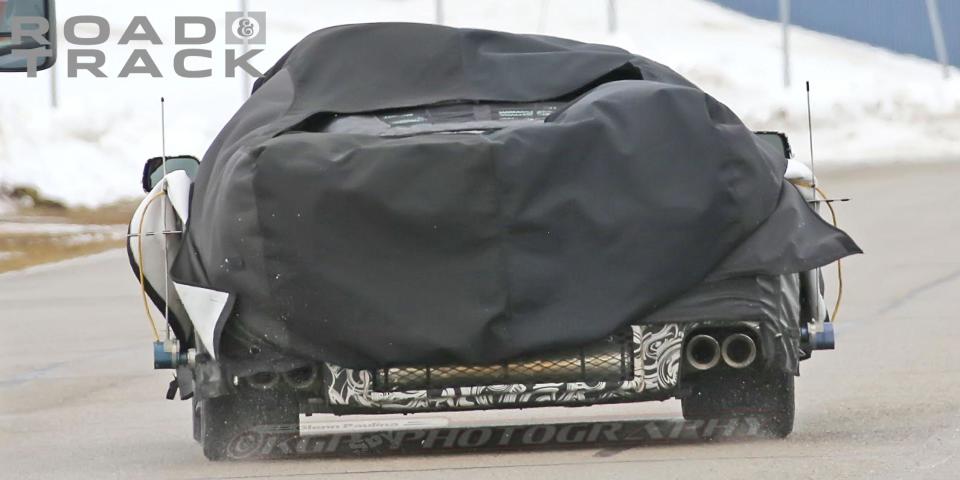It's Finally Time for the Chevrolet Fiero

Are we really getting a mid-engined Corvette, after all these years? I'm reminded of the statement supposedly made by Charles de Gaulle after a state visit to South America in the early Sixties: "Brazil is the country of the future… and it always will be." But let's not get too snarky about it. There are things to like about the idea of a 'Vette with the engine behind the seats, and there are things that won't be so great, and if the car ever actually reaches production we will all have plenty of time to complain about it on the Internet.
No, what's animating my hopes and dreams right now is this: If a mid-engined sports car is good enough to be the de facto flagship of General Motors, isn't it good enough for younger, less well-heeled drivers as well? Wouldn't it be a good idea to have another product on which the estimable halo of the presumably-mighty C8 could shine a little more directly than it does on, say, a Cruze hatchback? And wouldn't it be great if there was an affordable way to create an impressively capable performance car using off-the-shelf parts? The answer to all of those questions, of course, is "hell yes"-and I'll show you how it could be done.
Way back in 1891, the Systeme Panhard laid down the basic template that would guide much of automotive engineering all the way to the present day: a longitudinally-mounted engine over the front wheels, turning a driveshaft that ran back to a differential between the rear wheels. It was such a successful concept that most people aren't even aware that it had to be invented. I suspect that if you asked most people to sketch out "the first car" ever they would sketch out a Systeme Panhard rather than any of the designs that preceded it, none of which had an engine up front and drive wheels out back.

Obviously, not every mass-market car followed that script-the VW Type 1 "Beetle," of course, was a rear-engined, RWD car and it was far from the first one. But it fell to Sir Alec Issigonis to really shake things up with his original Mini, which pioneered the transverse powertrain as we know it today. In the Issigonis layout, we have a sideways-mounted engine/transaxle which drives the wheels directly.
It's not the most space-efficient powertrain layout ever conceived; that honor would probably go to the rear-engine layouts of the Smart car or the Mitsubishi i. But it's probably the best compromise between serviceability, function, and ease of installation. If you've ever visited a factory where modern FWD cars like the Honda Accord or Toyota Camry are made, you might have seen the process by which the whole drivetrain is simply shoved up through the car's nose in a single motion then secured with the tightening of just a few bolts.
But there's another fascinating aspect of an Issigonis-pattern powertrain: it's not just for FWD cars. You could just as easily mount the whole thing in the back to create a transverse-engined RWD vehicle, although hardly anybody ever bothers to do it. You could also rotate the powertrain 180 degrees and put it between the seats and the rear wheels. Pow! Instant mid-engined car, with almost zero engineering effort required.
If this sounds vaguely familiar, it's because it's how we got the Pontiac Fiero. Take the powertrain out of a Chevrolet Citation, and turn it 180 degrees. You can even keep the tie rods that were used to steer the Citation! Just bolt them in without a steering rack. And that's how you get a Fiero powertrain, in either "Iron Duke" four-cylinder or V6 form.

Add the front suspension from the Chevette, and you've got yourself an instant low-cost mid-engined "sports car." We tend to remember the Fiero nowadays as a punchline, but the truth was that a lot of people wanted that sort of car at the time and the Fiero was both handsome and affordable. And while the car had no shortage of quality issues, the basic concept of turning an economy-car powertrain around to create a mid-mounted sports-car was proven to everyone's satisfaction. In the years to come, everybody from English cottage-industry builders to Lamborghini would find themselves using FWD-inspired engine/transmission packages.
Which brings us to the current day and to the opportunities presented by a range-topping mid-engined Corvette. No matter whether the car is good or bad, it's unlikely to be cheap, which means that there's a place in the showroom for a lower-cost product with a perceived connection to the C8. Which is where my idea for a Chevrolet Fiero comes in.
Start with the omnipresent 3.6-liter GM V6. It's a strong engine, making well over 300 horsepower in a couple different transverse applications. Just flip it around and stuff in the back of a small plastic-bodied sports car. The front suspension could come from the Cadillac ATS; the discerning people at Elan Motorsports have a very high opinion of that suspension, which is why they're using many of its components in the NP-01 spec racing prototype.

The rest of the car could come out of the GM parts bin. You'd really only need to engineer a proper aluminum frame and plastic body, but after multiple generations of post-fiberglass Corvettes, to say nothing of the original Fiero, this will not be unfamiliar territory for the General. In a perfect world, there would be a six-speed manual transmission, but ninety percent of the buyers probably want an automatic or double-clutch gearbox so maybe it's easiest just to use the whole powertrain as seen in, say, the previous-generation Chevrolet Impala.
The original Fiero was a two-seater, but that was before Americans got into this strange habit of having fewer children than ever before while simultaneously demanding more doors and more seats in their daily drivers. So let's make a truly heretical proposition: the new car should be a four-seater, like a Lotus Evora. Even if nobody uses the back seats, they're nice to have.
With today's technology, it should be easy to hit a curb weight target of 2,999 pounds. Tune up the V6 for 340 horsepower or thereabouts and you'll have no reason to fear anything priced much below fifty grand in the stoplight grand prix. And will it handle? Of course it will. If the recent run of special-badge Camaros has taught us anything, it's taught us that GM now truly understands how to deliver world-class grip and response in a sporting automobile.
What should it cost? I'm thinking the sticker should fall between the Malibu and the Impala, with maybe a target base price of $29,999. No, it wouldn't sell a million copies. But it would enable GM to start having a conversation with the most affluent, well-educated young car enthusiasts. The kind of people who gravitate to the GTI and the 2-Series BMW nowadays. It's a chance to get them started in a Chevrolet nice and early. Alfred Sloan would approve.
Of course, Mr. Sloan would tell you that you need a better name than "Fiero." And it so happens that I have just the thing. It respects the heritage and it's got no recent baggage to overcome. What better name for a sporty, rapid, affordable mid-mounted four-seater than… Chevrolet Corvair?
You Might Also Like

 Yahoo Autos
Yahoo Autos 